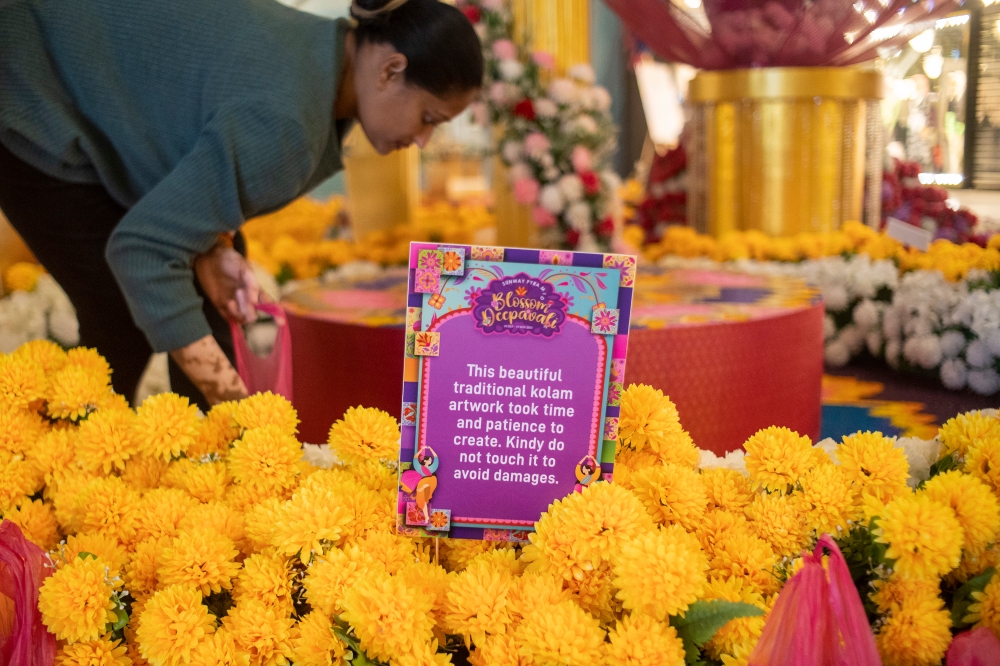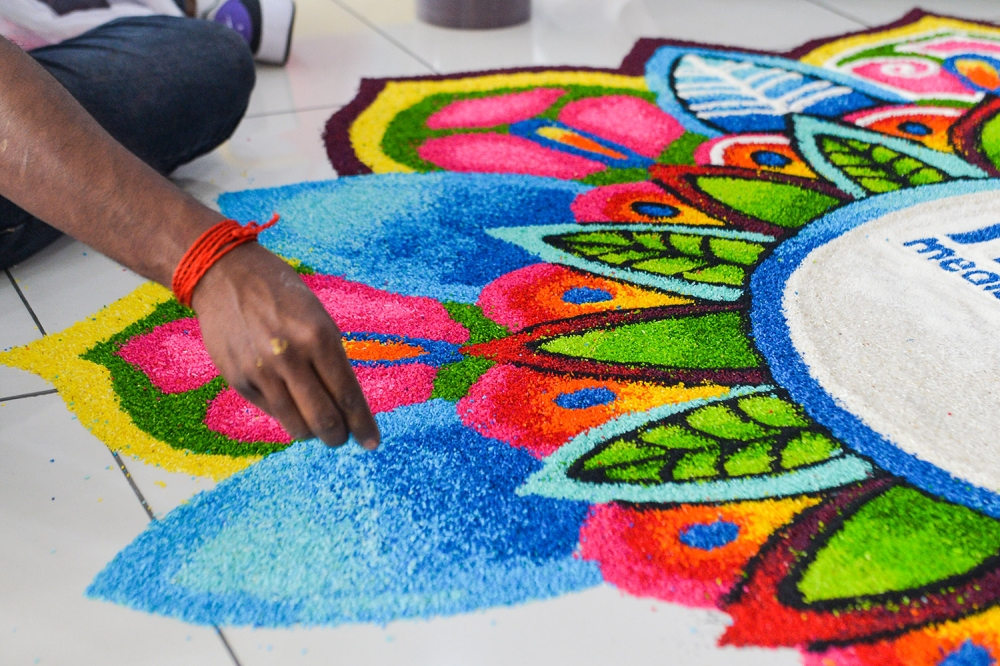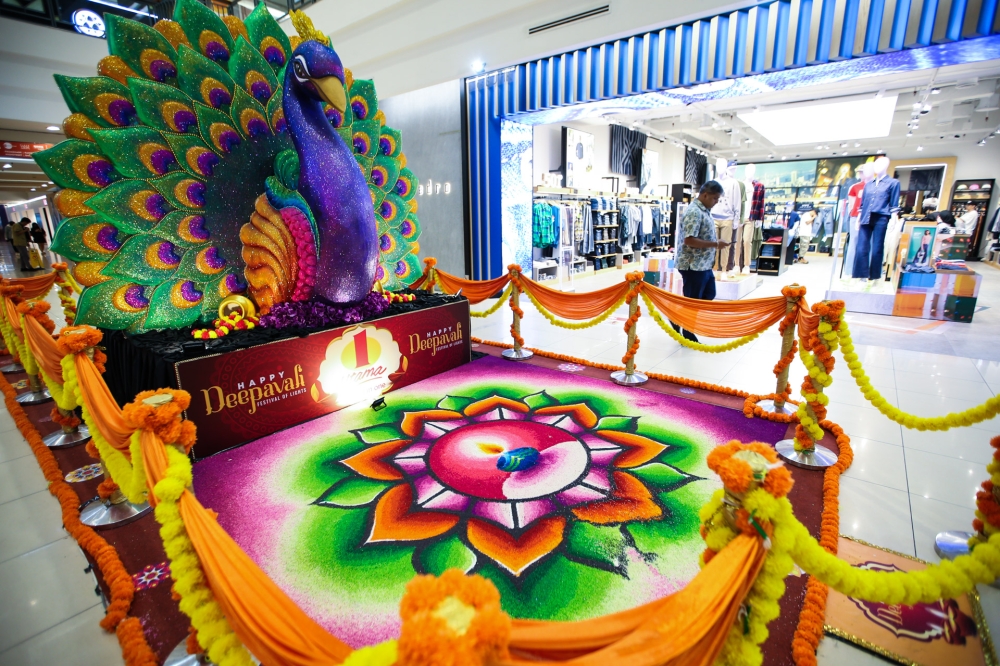Kolam: Casting light on an under-appreciated art form

A family take a selfie with the Kolam decoration at the Court Hill Sri Ganesar Temple in Kuala Lumpur. — Picture by Firdaus Latif
Sunday, 12 Nov 2023 7:00 AM MYT
KUALA LUMPUR, Nov 12 — In Malaysia, Kolam are a common sight in public places, such as shopping mall atriums, bank foyers, and the concourses of public transportation hubs, during the Deepavali festive period.
And while we might stop to admire the intricate geometric designs drawn with colourful rice flour, how many of us really understand this art form and its symbolism and meaning?
To find out more, Malay Mail sought out a few Kolam artists who spoke about their craft and its significance.
Mood lifter and symbol of heartfelt hospitality
Mehnaga Mathivanan, or fondly known as Anjali, 42, said the Kolam has taken on a cultural connotation in Malaysia despite, historically, having religious roots.
In India, Anjali said locals create Kolam daily at the entrance of their home to invite Goddess Lakshmi, the Hindu goddess of wealth, into the household, and drive away evil spirits.
She added that rice flour is used so that ants can eat it, which is believed to dispel bad karma and bring more blessings.
“It can also lift a person’s mood if they are upset or angry. Kolam is a beautiful thing to see or even gaze at. The colourful design can actually brighten people up. There is a psychological aspect to it,” she said when met by Malay Mail at Sunway Pyramid shopping mall recently.

Mehnaga Mathivanan, or fondly known as Anjali, 42, repairing her Kolam at Sunway Pyramid shopping mall. — Picture by Shafwan Zaidon
Another local artist, who wished to be known as Siran, 46, said Kolam is seen as a wonderful way to welcome the festival of lights.
He also said that renditions of peacocks and lamps usually take pride of place alongside a Kolam design.
“I tend to create my own designs that incorporate customers’ requirements, such as their company logo or name.
“Peacocks and lamps also feature prominently in Kolam for Deepavali, as they are particularly significant,” he told Malay Mail when contacted.
Peacocks are associated with Hindu gods who are often depicted with the birds, or as wearing their feathers which are a symbol of prosperity.
Lamps, on the other hand, symbolise the triumph of light over dark, and good over evil.
For Sivabalan Arumugam, 36, he said Kolam embody spirituality, beauty, hospitality, and remarkable dedication.
“The meticulous effort invested in crafting a kolam should be appreciated, as it reflects the artist’s dedication to offering heartfelt hospitality.
The enchanting beauty of a kolam has the power to brighten one’s day, imparting a serene sense of inner peace,” he said.
He added that he drew inspiration from traditional Indian art and design, such as lotus flowers, peacocks and Rangoli patterns.
“Themes are usually based on the client’s request, but personally, I prefer something that looks grand, yet is humble in its own way,” said Sivabalan.

Kolam artist, Sivabalan Arumugam, 36, at work. — Picture by Miera Zulyana
The making of Kolam
Sivabalan explained that Kolam in Malaysia and South Asia have a common origin but differ in some ways.
“While both share similar decorative patterns, Malaysian kolam are influenced by local culture, so they feature various patterns, colours, and materials.
“South Asian kolams usually stick to traditional designs using rice flour, while Malaysian ones often incorporate different materials to fit local customs and preferences,” he said.
Anjali said the drafting of a Kolam takes hours from the moment of drafting to its completion.
She added that a Kolam measuring four feet in diameter takes her two hours.
“It really depends on the design and the size. The smaller ones are harder and longer to finish for me, because you don’t want the colours to mix.
“For example, bright and dark pink can’t be mixed together; if not, it’s not pleasing to the eye,” she said.
Anjali said the cost of making a Kolam is about RM300 per square feet.
For Siran, he said small Kolam take about 30 minutes to an hour and a bigger one, four to five hours.
He partnered with 1 Utama Shopping Centre for a display of two Kolam and two peacock sculptures at the centre court of the mall.

The Kolam decoration at 1 Utama Shopping Centre. — Picture by Ahmad Zamzahuri
According to Ai Ping, manager of the 1 Utama Advertising and Promotion Department, the two Kolam took six hours to complete.
“The planning was about four weeks as we designed it ourselves. The inspiration behind the display design is the peacock, which symbolises good luck and prosperity for Hindus, with two peacock sculptures meaning double luck and double prosperity,” she said.
Ai Ping revealed that the entire commission cost about RM30,000.
This year, the Kolam displayed at Subang Jaya Medical Centre, The Gardens Mall Kuala Lumpur, and Maybank’s SS15 branch were all by Anjali.
Outside of Deepavali festive season, Anjali and Siran said they get bookings to create Kolam for weddings and engagements.
But Siran said demand has slowed after Covid-19, and he labelled this year as “average”.
For Sivabalan, his work can be seen at Klang Valley shopping centres and offices, such as Paradigm Mall, EQ Hotel, Quill City Mall, Subang Parade and the Volvo showroom.
Look, no touch
Knowing the painstaking work that goes into the creation of a Kolam makes many of us feel awful when we see one damaged.
Suffice to say, this affects the artists greatly.

The Gardens Mall draws inspiration from horses for its colourful Kolam, which are meticulously made using coloured rice, rice flour, lentils and white rock powder. — Picture by Raymond Manuel
Anjali expressed to Malay Mail the disappointment that she felt every time her art is destroyed as it made her feel like it was not appreciated.
“The art will never be the same once it is destroyed,” she said when tending to her damaged work at the Sunway Pyramid shopping mall.
“The colour had to be mixed. I can’t just sweep away everything and start from scratch,” she said.
Anjali said sadly, it is mostly adults who have the itchy fingers.
“Babies, you can’t really blame them. They don’t know better. Kindergarten kids are okay. Usually, they are curious about it and ask questions instead.
“But the adults, they take photos, and they want to go as near as they can to the Kolam, and eventually, mess it up. Every year, it is the same,” she said.
Siran said the onus is on parents to explain the Kolam to their children.
“We have kids playing with the Kolam. But we can’t blame them also because they are attracted to the colours.
“I have been doing this job for more than 30 years. I face the same situation after my job is done and the kids play and damage it. I can’t blame them. The parents should teach them and guide their kids. Explain to them, then only they will understand,” he said.
Hindus celebrate Deepavali during the Hindu calendar month of Kartika (between mid-October and mid-November), which marks the day Lord Krishna defeated the demon king Narakasura.
Deepavali is being celebrated nationwide today.
No comments:
Post a Comment